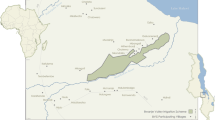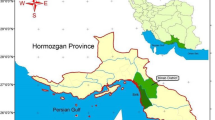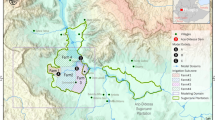Abstract
Previous research models have used climate data to explain habitat conditions of Anopheles mosquitoes transmitting malaria parasites. Although they can estimate mosquito populations with sufficient accuracy in many areas, observational data show that there is a tendency to underestimate the active growth and reproduction period of mosquitoes in semi-arid agricultural regions. In this study, a new, modified model that includes irrigation as a factor was developed to predict the active growing period of mosquitoes more precisely than the base model for ecophysiological and climatological distribution of mosquito generations (ECD-mg). Five sites with complete sets of observational data were selected in semi-arid regions of India for the comparison. The active growing period of mosquitoes determined from the modified ECD-mg model that incorporated the irrigation factor was in agreement with the observational data, whereas the active growing period was underestimated by the previous ECD-mg model that did not incorporate irrigation. This suggests that anthropogenic changes in the water supply due to extensive irrigation can encourage the growth of Anopheles mosquitoes through the alteration of the natural water balance in their habitat. In addition, it was found that the irrigation systems not only enable the active growth of mosquitoes in dry seasons but also play an important role in stabilizing the growth in rainy seasons. Consequently, the irrigation systems could lengthen the annual growing period of Anopheles mosquitoes and increase the maximum generation number of mosquitoes in semi-arid subtropical regions.




Similar content being viewed by others
References
Allen RG, Pereira LS, Raes D, Smith M (1998) Crop evapotranspiration: guidelines for computing crop water requirements. FAO Irrigation and Drainage Paper 56. Food and Agriculture Organization of the United Nations, Rome
Arora VK (2006) Application of a rice growth and water balance model in an irrigated semi-arid subtropical environment. Agric Water Manag 83:51–57
Baeza A, Bouma MJ, Dobson AP, Dhiman R, Srivastava HC, Pascual M (2011) Climate forcing and desert malaria: the effect of irrigation. Malar J 10:190. doi:10.1186/1475-2875-10-190
Bhatt RM, Sharma RC, Gautam AS, Gupta DK (1991) Seasonal prevalence of anophelines in Kheda district, Gujarat. Indian J Malariol 28:29–40
Chandra G (2008) Age composition of incriminated malaria vector in a rural foothills in West Bengal, India. Indian J Med Res 127:607–609
Chareonviriyaphap T, Bangs MJ, Ratanatham S (2000) Status of malaria in Thailand. Southeast Asian J Trop Med Public Health 31:225–237
Craig MH, Snow RW, le Sueur D (1999) A climate-based distribution model of malaria transmission in sub-Saharan Africa. Parasitol Today 15:105–111
Dunne KA, Willmott CJ (1996) Global distribution of plant-extractable water capacity of soil. Int J Climatol 16:841–859
Ebi KL, Hartman J, McConnell JK, Chan N, Weyant J (2005) Climate suitability for stable malaria transmission in Zimbabwe under different climate change scenarios. Clim Chang 73:375–393
FAS (2012) Crop Calendars for Australia Bangladesh India Pakistan. http://www.fas.usda.gov/remote/aus_sas/crop_information/calendars/clndr_jan.htm. Foreign Agricultural Service, US Department of Agriculture. Accessed 8 March 2012
Gong H, DeGaetano AT, Harrington LC (2011) Climate-based models for West Nile Culex mosquito vectors in the Northeastern US. Int J Biometeorol 55:435–446
Gupta S, Gunter JT, Novak RJ, Regens JL (2009) Patterns of Plasmodium vivax and Plasmodium falciparum malaria underscore importance of data collection from private health care facilities in India. Malar J 8:227
Herrel N, Amerasinghe FP, Ensink J, Mukhtar M, van der Hoek W, Konradsen F (2001) Breeding of Anopheles mosquitoes in irrigated areas of South Punjab, Pakistan. Med Vet Entomol 15:236–248
Herrel N, Amerasinghe FP, Ensink J, Mukhtar M, van der Hoek W, Konradsen F (2004) Adult anopheline ecology and malaria transmission in irrigated areas of South Punjab, Pakistan. Med Vet Entomol 18:141–152
Hytteborn J (2005) Irrigation with wastewater in Andhra Pradesh, India, a water balance evaluation along Peerzadiguda canal. Dissertation, Swedish University of Agricultural Sciences
Jayaraman TK (1982) Malarial impact of surface irrigation projects: a case study from Gujarat, India. Agric Environ 7:23–34
Joshi V, Sharma RC, Singhi M, Singh H, Sharma K, Sharma Y, Adha S (2005) Entomological studies on malaria in irrigated and non-irrigated areas of Thar Desert, Rajasthan, India. J Vector Borne Dis 42:25–29
Kant R, Pandey SD (1999) Breeding preferences of Anopheles culicifacies in the rice agro-ecosystem in Kheda district, Gujarat. Indian J Malariol 36:53–60
Kearney M, Porter WP, Williams C, Ritchie S, Hoffmann AA (2009) Integrating biophysical models and evolutionary theory to predict climatic impacts on species’ ranges: the dengue mosquito Aedes aegypti in Australia. Funct Ecol 23:528–538
Konradsen F, Stobberup KA, Sharma SK, Gulati OT, van der Hoek W (1998) Irrigation water releases and Anopheles culicifacies abundance in Gujarat, India. Acta Trop 71:195–197
Lal S, Sonal GS, Phukan PK (2000) Status of malaria in India. J Indian Acad Clin Med 5:19–23
Lieshout M, Kovats RS, Livermore MTJ, Martens P (2004) Climate change and malaria: analysis of the SRES climate and socio-economic scenarios. Global Environ Chang 14:87–99
Mahmood F, Sakai RK, Akhtar K (1984) Vector incrimination studies and observations on species A and B of the taxon Anopheles culicifacies in Pakistan. Trans R Soc Trop Med Hyg 78:607–616
Martens P, Kovats RS, Nijhof S, de Vries P, Livermore MTJ, Bradley DJ, Cox J, McMichael AJ (1999) Climate change and future populations at risk of malaria. Global Environ Chang 9:S89–S107
Morin CW, Comrie AC (2010) Modeled response of the West Nile virus vector Culex quinquefasciatus to changing climate using the dynamic mosquito simulation model. Int J Biometeorol 54:517–529
Morse AP, Doblas-Reyes FJ, Hoshen MB, Hagedorn R, Palmer TN (2005) A forecast quality assessment of an end-to-end probabilistic multi-model seasonal forecast system using a malaria model. Tellus A 57:464–475
New M, Hulme M, Jones P (1999) Representing twentieth-century space-time climate variability. Part 1: development of a 1961–90 mean monthly terrestrial climatology. J Clim 12:829–856
NFSM (2011) Crop Calendar of National Food Security Mission Crops data. http://nfsm.gov.in/nfsmmis/RPT/CalenderReport.aspx. Government of India. Accessed 9 November 2011
NOAA (2011) Daily average temperature, rainfall and evaporation near each trap location, the National Oceanic and Atmospheric Administration. Accessed 2 November 2011
Ohta S, Kaga T (2011) Possible effects of future climate changes on the maximum number of generations of Anopheles in Monsoon Asia. In: Blanco J, Kheradmand H (eds) Climate change—geophysical foundations and ecological effects. InTech, Rijeka, pp 247–272
Ohta S, Kaga T (2012) Effect of climate on malarial vector distribution in Monsoon Asia: coupled model for Ecophysiological and Climatological Distribution of mosquito generations (ECD-mg). Clim Res 53:77–88
Ohta S, Kimura A (2007) Impacts of climate changes on the temperature of paddy waters and suitable land for rice cultivation in Japan. Agric For Meteorol 147:186–198
Ohta S, Uchijima Z, Seino H, Oshima Y (1993) Probable effects of CO2-induced climatic warming on the thermal environment of ponded shallow water. Clim Chang 23:69–90
Paaijmans KP, Heusinkveld BG, Jacobs AF (2008) A simplified model to predict diurnal water temperature dynamics in a shallow tropical water pool. Int J Biometeorol 52:797–803
Rowland M, Mahmood P, Iqbal J, Carneiro I, Chavasse D (2000) Indoor residual spraying with alphacypermethrin controls malaria in Pakistan: a community-randomized trial. Trop Med Int Health 5:472–481
Rowland M, Mohammed N, Rehman H, Hewitt S, Mendis C, Ahmad M, Kamal M, Wirtz R (2002) Anopheline vectors and malaria transmission in eastern Afghanistan. Trans R Soc Trop Med Hyg 96:620–626
Singh N, Mishra AK (2000) Anopheline ecology and malaria transmission at a new irrigation project area (Bargi Dam) in Jabalpur (Central India). J Am Mosq Control Assoc 16:279–287
Singh N, Nagpal AC, Saxena A, Singh MP (2004) Changing scenario of malaria in central India, the replacement of Plasmodium vivax by Plasmodium falciparum (1986–2000). Trop Med Int Health 9:364–371
Smith M (1992) CROPWAT: a computer program for irrigation planning and management. FAO irrigation and drainage paper 46. Food and Agriculture Organization of the United Nations, Rome
Tao F, Yokozawa M, Hayashi Y, Lin E (2003) Future climate change, the agricultural water cycle, and agricultural production in China. Agric Ecosyst Environ 95:203–215
Tyagi BK, Yadav SP (2001) Bionomics of malaria vectors in two physiographically different areas of the epidemic-prone Thar Desert, north-western Rajasthan (India). J Arid Environ 47:161–172
WHO (2010) World malaria report 2010. World Health Organization, Geneva
Yamamura K, Kiritani K (1998) A simple method to estimate the potential increase in the number of generations under global warming in temperate zones. Appl Entomol Zool 33:289–298
Acknowledgments
This study was funded in part by the Ministry of Education, Science and Culture of Japan (Grant-in-Aid for Scientific Research C–21510022, C–24510020) and a Waseda University Grant for Special Research Projects (2010A–088, 2011A–079).
Author information
Authors and Affiliations
Corresponding author
Electronic supplementary material
Below is the link to the electronic supplementary material.
ESM 1
(PDF 105 kb)
Rights and permissions
About this article
Cite this article
Ohta, S., Kaga, T. Effect of irrigation systems on temporal distribution of malaria vectors in semi-arid regions. Int J Biometeorol 58, 349–359 (2014). https://doi.org/10.1007/s00484-012-0630-y
Received:
Revised:
Accepted:
Published:
Issue Date:
DOI: https://doi.org/10.1007/s00484-012-0630-y




